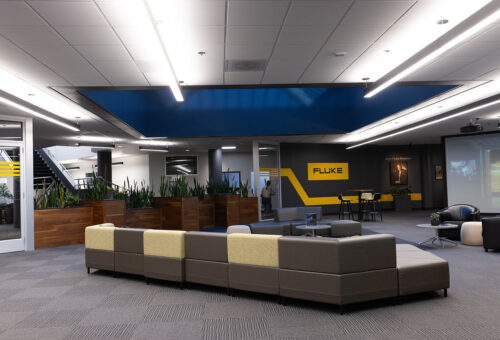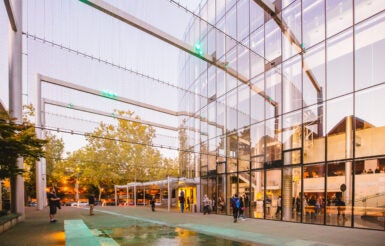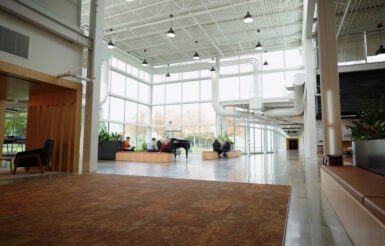Project Overview
Simplicity, flexibility, and savings
Picture a manufacturing headquarters with outdated fluorescent lighting, limited controls, and little flexibility across a wide area with many different uses. This is what Fluke Corporation, a multi-national manufacturer specializing in electronic test measurement, was dealing with. They knew it was time to upgrade their lighting system so they reached out to their local utility to learn about their options.
Getting started
To achieve Fluke’s goal of reducing energy consumption, Facility Administrator and Project Manager, Deson Jackson, researched various lighting systems that could meet this objective. Jackson’s first call was to Orion Eaton, an Energy Management Engineer at Snohomish County PUD. Their conversation illuminated Jackson to the options available through the utility’s commercial lighting retrofit program.

LLLC, a type of networked lighting control (NLC) system that integrates both sensors and load controllers into each individual fixture, was the best solution to replace fluorescent fixtures throughout Fluke’s facility. With a wireless, flexible system streamlining installation and reducing energy costs, LLLC was an easy choice.
The challenge
Fluke had a variety of LED and fluorescent fixtures installed in the interior and exterior of the facility, as well as parking lot lights. Not only did they need to upgrade the 1,650 fluorescent fixtures to LED with LLLC, they also had 1,800 LED fixtures that had been retrofitted without controls.
To gain interest from upper management on the project to install controls, Jackson knew he needed to find a cost effective way to add controls to the existing lighting and secure upper management’s approval. He worked closely with Eaton to analyze the energy savings potential, and discovered that retrofitting the current LED fixtures with the same LLLC system would yield more than enough savings to qualify for a utility incentive.
The solution
“Snohomish County PUD offers incentives to customers to lower their operating costs by making energy-efficient investments,” said Eaton. “We help calculate their savings before starting a retrofit project. We incentivize controls given their proven ability to futureproof savings and help customers adapt as rate schedules change.”
Snohomish County PUD provided a significant incentive, covering over half of the capital cost to upgrade to LLLC. Jackson took the business benefits and financials to his team at Fluke and received approval to move forward.
Over a total of 10 months, a crew installed the LLLC system of Avion lighting fixtures into a variety of spaces, including the factory, offices, hallways, stairwells, cafe, and maintenance and mechanical rooms. The LLLC system operates on a wireless Bluetooth mesh network, so it is flexible and easy to install without any rewiring.
The function of each factory space constantly shifts based on the type of equipment being built, so their lighting needs to adjust for the different types of work. With the LLLC system, Jackson can quickly optimize the light levels for various staff needs through the touch of an app. Additionally, because the system features daylight and occupancy sensing, the lights can automatically turn on or off based on when workers are present in each area or the amount of light entering the space.
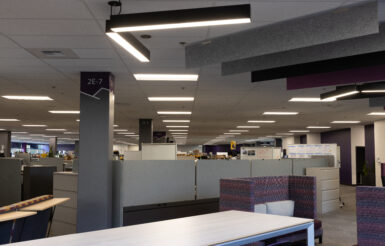
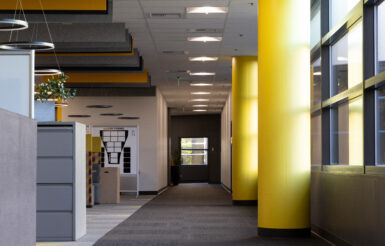
The results
More than 90% of Fluke’s headquarters is now retrofitted with LLLC, providing them with the flexibility and enhanced controls they were hoping to see. Fluke is estimated to save 54,803 kilowatt hours of energy annually. The project was so successful that Fluke was recognized in the U.S. Department of Energy’s (DOE) Integrated Lighting Campaign (ILC) for their commitment to energy efficiency and environmental responsibility in their facility.
Tips from Deson Jackson
-
Reach out to your local utility
Jackson encourages facility administrators and building owners looking for more control and flexibility to “go the LLLC route.” He shares that it’s helpful to “reach out to your local utility because they are a great resource and may offer incentives.”
-
Work with a manufacturer or contractor
Jackson has received significant support from his Avion factory rep along the way. “Make sure you work with a manufacturer or contractor that will provide you with the support you need to commission the project—as well as sufficiently educate you and your team on how to use it effectively after it is installed,” said Jackson.
About Fluke
Founded in 1948, Fluke Corporation is the world leader in compact, professional electronic test tools and software for measuring and condition monitoring. Fluke customers are technicians, engineers, electricians, maintenance managers, and metrologists who install, troubleshoot, and maintain industrial, electrical, and electronic equipment and calibration processes. FLUKE is a registered trademark of Fluke Corporation. For more information, visit the Fluke website.
How to get started with LLLC
To find the LLLC system that is best for you, you’ll first need to understand the performance and business benefits that are right for your space. Contact your local utility, visit betterbricks.com/LLLC, or reach out to the Northwest Trade Ally Network for free resources to get started.
